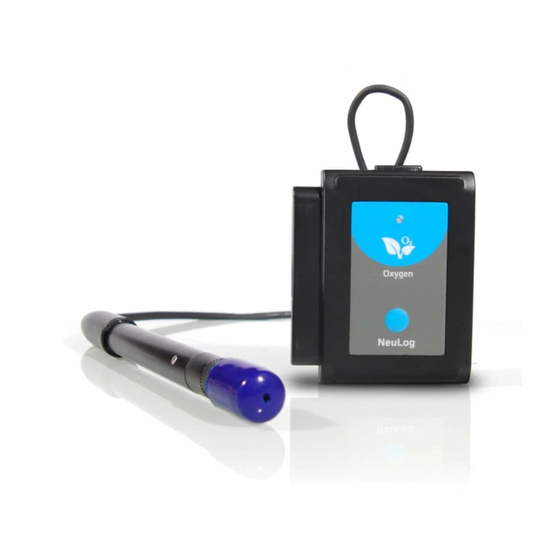
Advertisement
Quick Links
NeuLog oxygen logger sensor
NUL-205
The oxygen sensor can be used for any science experiment where oxygen levels,
dissolved or gaseous, are required. Some fields of study include Chemistry,
Physiology, Exercise Science, Biochemistry, Biology, Earth Science, Environmental
Science, etc.
The sensor comes pre-calibrated so you can start experimentation right out of the box
using this guide.
Just a few of the thousands of possible experiments that can be performed with the
NUL-205 sensor are: Monitoring of ecological systems, combustion reactions, oxygen
consumption rates, studying photosynthesis, testing chemical solutions and hydrogen
peroxide decomposition.
This sensor is practical for testing in school laboratories as well as in the field and has
two modes of operation: open air mode to test gaseous oxygen concentration
(percentage of oxygen in the air), and dissolved oxygen mode for the testing of liquids
(mg/L and percentage dissolved oxygen in a liquid).
The measurement units for this sensor are:
Oxygen % in air: The concentration of gaseous oxygen present in the
sample.
mg/L: Total mass of dissolved oxygen per liter of a given liquid sample.
Oxygen % in water: The percentage of dissolved oxygen present versus the
maximum level of oxygen saturation.
Sensor offset:
Although the NeuLog oxygen sensor does not need to be calibrated prior to each use,
it is recommended to offset its probe.
Open air mode:
Offset of the probe assumes a standard atmospheric oxygen concentration of 20.9%
(assuming stable levels in the Earth's atmosphere at sea level).
NEULOG OXYGEN LOGGER SENSOR GUIDE
1.
Connect the oxygen sensor to a voltage source (USB-200, BAT-200, WiFi-201).
Wait about 5 minutes after connecting the sensor to the voltage source before
you begin calibration and measurements. For a more accurate measurement,
look at the module window and wait for the reading to stabilize (it could take a
little longer).
2.
Remove the blue rubber cap from the oxygen sensor. Unscrew the membrane
cap, fill half of it with the filling solution and screw it back.
Press and hold the oxygen sensor's push button for 3 seconds while pointing the
3.
probe's tip towards the ground.
Dissolved oxygen mode:
Inserting air into water with an air pump or a 50 ml syringe will saturate the water to
100% of its capacity. The quantity (mg/L) depends on the water temperature.
1.
Connect the oxygen sensor to a voltage source (USB-200, BAT-200, WiFi-201).
2.
Remove the blue rubber cap from the oxygen sensor. Unscrew the membrane
cap, fill half of it with the filling solution and screw it back.
3.
Submerge the sensor in water.
4.
Saturate the water with oxygen using an air pump (manual or electric).
Press and hold the oxygen sensor's push button for 3 seconds.
5.
Quick start procedure:
PC or Mac Computer
Materials needed:
NUL-205 Oxygen Sensor
USB-200 USB Module
USB to mini USB cable (included with the USB-200 module)
Your oxygen sensor needs to be connected to a USB-200 module. The USB-200
module then connects to a computer via a USB to mini-USB cable. Please note that
you cannot plug the oxygen sensor directly into the computer.
Resident PC software and browser based application can be downloaded for free at
www.neulog.com/Download/SoftwareandApplication.aspx
user guide.
Note: Make sure not to download and install both types of software they will conflict
on the computer.
as well as a full software
Advertisement

Summary of Contents for NeuLog NUL-205
- Page 1 Sensor offset: you cannot plug the oxygen sensor directly into the computer. Although the NeuLog oxygen sensor does not need to be calibrated prior to each use, Resident PC software and browser based application can be downloaded for free at www.neulog.com/Download/SoftwareandApplication.aspx...
- Page 2 Take your tablet or smart phone, go to the Wi-Fi settings and select the Neulog Prior to initial use, the Neulog oxygen sensor needs to be offset; please review the “Sensor Offset”...
- Page 3 Prior to initial use, the Neulog oxygen sensor needs to be offset, please review Select which experimental data to upload (5 experimental runs can be stored at the “Sensor Offset”...
- Page 4 Replacement membrane cap for the oxygen sensor. ability to store its own data due to an internal flash memory chip and micro-controller Sensor specifications in each plastic Neulog body. This technology allows the sensor to collect and then In air Dissolved (%)
- Page 5 P: 1.866.553.8536 V05162013 Maintenance and storage: Never submerge the Neulog sensor’s plastic body in any liquid. Do not allow liquid into the Neulog plastic body. After using the probe, wipe off all excess material, liquid or residue from the oxygen probe body.
















Need help?
Do you have a question about the NUL-205 and is the answer not in the manual?
Questions and answers